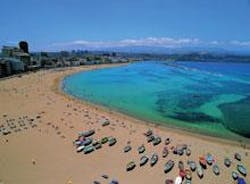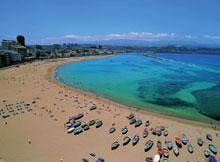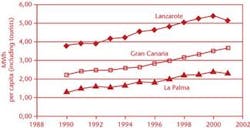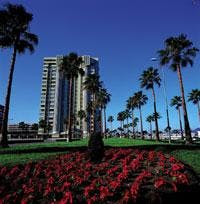Problems of sustainability – the two sides of desalination
By Manuel Hernández-Suáres
Recent data from the working document of the Canary Islands' Hydrological Plan reveal the archipelago's heavy dependence on desalination for its economy and drinking water supply. Further development of desalination plants, however, should include the use of renewable energy instead of fossil fuels.
Approximately 50% of the population in the Canary Islands depend on desalinated water supplies. Desalin-ation requires energy; which accounts for nearly 50% of the costs incurred in producing potable drinking water. Consequently, any increase in desalinated water production results in higher energy consumption.
Ninety-four percent of the electricity consumed on the islands comes from fuel-oil consumption, according to the latest statistics. Nevertheless, this relationship between desalination and energy, although generally a concern, is not often discussed outside technical circles.
It should not be forgotten that the commitment made by Spain and the European Union with respect to the Kyoto protocol includes the obligation to reduce greenhouse gases production, among them carbon dioxide (CO2). Given that water production in the Canary Islands appears to be linked directly and increasingly to oil combustion, and that economic and population growth implies greater water consumption, renewable energy sources must be tapped for use in water production and water reuse facilities in order to reduce CO2 emissions.
One example of the way in which three variables - water, population and energy - appear to be linked in the economic development of an island that is essentially near-desert is the case of Lanzarote. Similar graph curves are obtained for Fuerteventura, another fast-growing island.
Economic sustainability depends not only on land use, which is typically understood in terms of landscape and soil protection, but also on the use of natural resources in a manner that ensures that they are never depleted. In the Canary Islands, water resources have been overexploited on the majority of islands, resulting in an unsustainable economy in terms of natural resources.
Seawater is considered a limitless supply for desalination. The technology has been given carte blanche to keep the economy growing and prevent water scarcity from limiting further development. However, under current conditions, rising CO2 emissions will prove to be the limiting factor. For this reason, the energy source must be included into any discussion on the sustainability of desalination.
The exploitation of certain natural resources, such as virgin beaches and sunny climate, without natural water resources is guaranteed with desalination. Its environmental impact is minimal in terms of land use, atmospheric pollution or the release of brine, compared to the socio-economic growth that it triggers. Nevertheless, the environmental impact assessments performed on desalination facilities usually focus on these problems, forgetting perhaps the most difficult problem of all — how to articulate socio-economic development around desalination. Failure to address this issue can, obviously, harm the environment in the long term.
For example, desalinated water facilitates comfortable urban development and an increase in water consumption to values similar to those from areas in which water flows from conventional natural resources, such as rivers, springs and wells. Initially, desalination facilities were installed where there was a strong demand capable of covering the investment costs involved. Nowadays, the costs have decreased to such an extent that this is no longer the case, and investments may be covered by practically any activity, including agriculture.
Costs have dropped so much that they are now competitive compared to those involved in raising water from wells measuring 400 metres in depth, which amount to approximately 2.3 kWh/m3. Groundwater extraction with wells or excavated mountain tunnels continues to be profitable in inland areas; however this is hardly the case in coastal areas with water demand pressures.
Obviously, energy consumption is linked not only to the production of desalinated water but also to the type of economic activity undertaken - industrial, tourism-related or agricultural. Energy consumption differs in each case. Figure 2 compares the evolution of electricity consumption per capita for three islands having very different economies: Lanzarote, Gran Canaria and La Palma. In Lanzarote, the island consumes practically only desalinated water and has a tourism-based economy. In La Palma, the economy depends mainly on agriculture with no desalination on the island. In view of these clear socio-economic differences, it is not surprising that consumption per capita in La Palma should be less than half that of Lanzarote. Between these two extremes is Gran Canaria. Its diversified economy includes some agriculture and the production of desalinated water equivalent to 50% of the total consumed.
The rate at which atmospheric warming is taking place indicates the urgency with which greenhouse gas reduction measures must be respected. The data collected in the Canary Islands should be significant, inasmuch as they were taken in the middle of the ocean and spring from an environment that has remained constant for many years.
Temperature increases observed at the Los Rodeos airport in Tenerife amount to almost 3ºC over the last 30 years, which is a significant increase, and even more so if the temperature continues to rise over the next 30 years, as studies suggest, unless measures are taken on a global scale.
Consequently, pressure to reduce greenhouse gas emissions is expected to increase and, although reducing CO2 emission levels on the islands would serve little purpose since their contribution is minimal compared to the production of large countries, EU legislation obliges all alike, and will add emphasis to meet emission reduction requirements.
Overall, the impact of desalination on energy consumption in the archipelago may be estimated by considering the production of desalinated water on each island and multiplying it by an estimated factor of 5 kWh/m3 of desalinated water. In industrialised countries with warm climates, energy consumption is generally divided as follows - a third for industry, a third for commerce and a third for domestic use. Results reveal that energy consumption from desalination plants is very significant.
The worldwide phenomenon - water scarcity - revealed itself on the Canary Islands several decades ago. The construction of desalination plants solved this problem to the extent possible, but new limitations to growth have emerged due to the increase in CO2 emissions.
In conclusion, there can be seen an urgent need to look at actions allowing water production, distribution and reuse to be coupled with the implementation of renewable energy sources, in order to achieve sustainable progress in economic development on the archipelago.
Author's NoteManuel Hernández-Suárez, Ph.D., M.Sc., Dipl. Ing. is head of the Canary Islands Water Centre, based in Santa Cruz de Tenerife. For more information, visit the website www.fcca.es.





